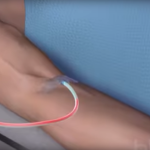 Transfusion of blood and its components
Transfusion of blood and its components
Indications for the transfusion of blood and its components
 There are two categories of indications for the procedure of blood transfusion: absolute and relative .
There are two categories of indications for the procedure of blood transfusion: absolute and relative .
Examples of absolute indications are profuse blood loss, terminal state, shock. Relative indications include cases in which blood transfusion is only one of the components of treatment. In such situations, it is necessary to carefully consider the patient's contraindications for surgery in order to prevent complications. In acute anemia and leukemia, only erythrocyte mass is transfused. In some cases, transfusion of blood plasma is performed. These include DIC, profuse blood loss of more than a third of the total circulating blood volume, coagulopathy, an overdose of anticoagulant drugs, a decrease in blood clotting factors (for example, with hepatitis) and some other abnormalities.
Order of conduct
The rules for blood transfusion are regulated by the order of the Ministry of Health of 04/02/2013 No. 183n.
The entire blood transfusion procedure must be carried out by a doctor.
Instructions for the transfusion of blood and its components consists of the following sequence of actions.
- First of all, indications for transfusion are established, contraindications are checked and the history of blood transfusions is analyzed. Women are also asked about pregnancies and their progress.
- Then the blood type and Rh factor of the recipient are determined.
- After that, a selection of donor blood is made and its condition is assessed according to a number of criteria (expiry date, container integrity, vial documentation and type of blood).
- The selected blood type of the donor (from the vial) is checked again.
- Then the compatibility of the material is analyzed according to the AB0 system and the Rh factor.
- In addition, before the procedure, it is necessary to conduct a biological test due to the existence of many secondary blood groups: three times with an interval of three minutes, the recipient is injected with the donor's blood, 20 ml intravenously. Blood transfusion can be performed if the patient has not changed such indicators as complexion, pulse, respiratory rate, etc.
Donor blood transfusion procedure.
According to the protocol, the rate of blood transfusion is 40-60 drops per minute. Simultaneously with the operation, blood pressure, pulse rate and body temperature are measured. The values are entered into the patient's chart. After the procedure, the patient lies for two hours and is under the supervision of a specialist for a day. A day later, the patient gives a general analysis of urine and blood. One of the signs of complications during surgery is brown urine.
In parallel with these procedures, documentation is being filled out.
Including the consent of the patient to the operation of transfusion of blood components. For two days, 10 ml of donor blood and patient's serum are stored in the refrigerator to analyze possible complications. According to the same rules as blood transfusion, red blood cell transfusion is performed.
In some cases, it is necessary to carry out a blood transfusion procedure during surgery. Due to the slowdown in the manifestation of all patient immune responses, there are features of evaluating a biological sample for such cases. Analysis of a biological sample is carried out using a microscope. The criterion is the absence of agglutinated erythrocytes.
For clarity, we recommend watching this video: